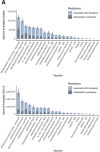Global and regional burden of attributable and associated bacterial antimicrobial resistance avertable by vaccination: modelling study
- PMID: 37414432
- PMCID: PMC10335446
- DOI: 10.1136/bmjgh-2022-011341
Global and regional burden of attributable and associated bacterial antimicrobial resistance avertable by vaccination: modelling study
Abstract
Introduction: Antimicrobial resistance (AMR) is a global health threat with 1.27 million and 4.95 million deaths attributable to and associated with bacterial AMR, respectively, in 2019. Our aim is to estimate the vaccine avertable bacterial AMR burden based on existing and future vaccines at the regional and global levels by pathogen and infectious syndromes.
Methods: We developed a static proportional impact model to estimate the vaccination impact on 15 bacterial pathogens in terms of reduction in age-specific AMR burden estimates for 2019 from the Global Research on Antimicrobial Resistance project in direct proportion to efficacy, coverage, target population for protection, and duration of protection of existing and future vaccines.
Results: The AMR burden avertable by vaccination in 2019 was highest for the WHO Africa and South-East Asia regions, for lower respiratory infections, tuberculosis, and bloodstream infections by infectious syndromes, and for Mycobacterium tuberculosis and Streptococcus pneumoniae by pathogen. In the baseline scenario for vaccination of primary age groups against 15 pathogens, we estimated vaccine-avertable AMR burden of 0.51 (95% UI 0.49-0.54) million deaths and 28 (27-29) million disability-adjusted life-years (DALYs) associated with bacterial AMR, and 0.15 (0.14-0.17) million deaths and 7.6 (7.1-8.0) million DALYs attributable to AMR globally in 2019. In the high-potential scenario for vaccination of additional age groups against seven pathogens, we estimated vaccine-avertable AMR burden of an additional 1.2 (1.18-1.23) million deaths and 37 (36-39) million DALYs associated with AMR, and 0.33 (0.32-0.34) million deaths and 10 (9.8-11) million DALYs attributable to AMR globally in 2019.
Conclusion: Increased coverage of existing vaccines and development of new vaccines are effective means to reduce AMR, and this evidence should inform the full value of vaccine assessments.
Keywords: Immunisation; Vaccines.
© Author(s) (or their employer(s)) 2023. Re-use permitted under CC BY. Published by BMJ.
Conflict of interest statement
Competing interests: None declared.
Figures




References
-
- WHO . Global action plan on antimicrobial resistance. World Health Organization, 2015. - PubMed
-
- O’Neill J. Antimicrobial resistance: tackling a crisis for the health and wealth of nations. The Review on Antimicrobial Resistance 2014.
Publication types
MeSH terms
Substances
Grants and funding
LinkOut - more resources
Full Text Sources
Medical
